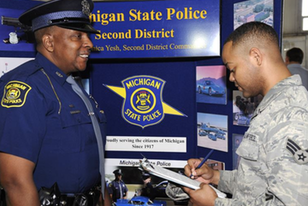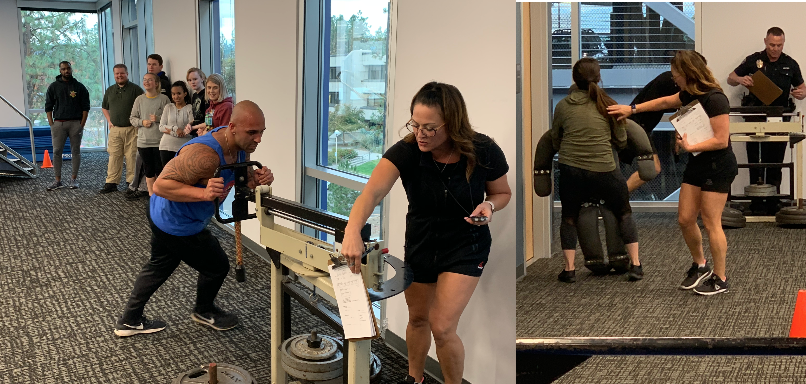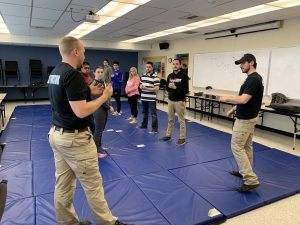6.5: Recruitment and Hiring in Policing
- Page ID
- 15964
\( \newcommand{\vecs}[1]{\overset { \scriptstyle \rightharpoonup} {\mathbf{#1}} } \)
\( \newcommand{\vecd}[1]{\overset{-\!-\!\rightharpoonup}{\vphantom{a}\smash {#1}}} \)
\( \newcommand{\id}{\mathrm{id}}\) \( \newcommand{\Span}{\mathrm{span}}\)
( \newcommand{\kernel}{\mathrm{null}\,}\) \( \newcommand{\range}{\mathrm{range}\,}\)
\( \newcommand{\RealPart}{\mathrm{Re}}\) \( \newcommand{\ImaginaryPart}{\mathrm{Im}}\)
\( \newcommand{\Argument}{\mathrm{Arg}}\) \( \newcommand{\norm}[1]{\| #1 \|}\)
\( \newcommand{\inner}[2]{\langle #1, #2 \rangle}\)
\( \newcommand{\Span}{\mathrm{span}}\)
\( \newcommand{\id}{\mathrm{id}}\)
\( \newcommand{\Span}{\mathrm{span}}\)
\( \newcommand{\kernel}{\mathrm{null}\,}\)
\( \newcommand{\range}{\mathrm{range}\,}\)
\( \newcommand{\RealPart}{\mathrm{Re}}\)
\( \newcommand{\ImaginaryPart}{\mathrm{Im}}\)
\( \newcommand{\Argument}{\mathrm{Arg}}\)
\( \newcommand{\norm}[1]{\| #1 \|}\)
\( \newcommand{\inner}[2]{\langle #1, #2 \rangle}\)
\( \newcommand{\Span}{\mathrm{span}}\) \( \newcommand{\AA}{\unicode[.8,0]{x212B}}\)
\( \newcommand{\vectorA}[1]{\vec{#1}} % arrow\)
\( \newcommand{\vectorAt}[1]{\vec{\text{#1}}} % arrow\)
\( \newcommand{\vectorB}[1]{\overset { \scriptstyle \rightharpoonup} {\mathbf{#1}} } \)
\( \newcommand{\vectorC}[1]{\textbf{#1}} \)
\( \newcommand{\vectorD}[1]{\overrightarrow{#1}} \)
\( \newcommand{\vectorDt}[1]{\overrightarrow{\text{#1}}} \)
\( \newcommand{\vectE}[1]{\overset{-\!-\!\rightharpoonup}{\vphantom{a}\smash{\mathbf {#1}}}} \)
\( \newcommand{\vecs}[1]{\overset { \scriptstyle \rightharpoonup} {\mathbf{#1}} } \)
\( \newcommand{\vecd}[1]{\overset{-\!-\!\rightharpoonup}{\vphantom{a}\smash {#1}}} \)
\(\newcommand{\avec}{\mathbf a}\) \(\newcommand{\bvec}{\mathbf b}\) \(\newcommand{\cvec}{\mathbf c}\) \(\newcommand{\dvec}{\mathbf d}\) \(\newcommand{\dtil}{\widetilde{\mathbf d}}\) \(\newcommand{\evec}{\mathbf e}\) \(\newcommand{\fvec}{\mathbf f}\) \(\newcommand{\nvec}{\mathbf n}\) \(\newcommand{\pvec}{\mathbf p}\) \(\newcommand{\qvec}{\mathbf q}\) \(\newcommand{\svec}{\mathbf s}\) \(\newcommand{\tvec}{\mathbf t}\) \(\newcommand{\uvec}{\mathbf u}\) \(\newcommand{\vvec}{\mathbf v}\) \(\newcommand{\wvec}{\mathbf w}\) \(\newcommand{\xvec}{\mathbf x}\) \(\newcommand{\yvec}{\mathbf y}\) \(\newcommand{\zvec}{\mathbf z}\) \(\newcommand{\rvec}{\mathbf r}\) \(\newcommand{\mvec}{\mathbf m}\) \(\newcommand{\zerovec}{\mathbf 0}\) \(\newcommand{\onevec}{\mathbf 1}\) \(\newcommand{\real}{\mathbb R}\) \(\newcommand{\twovec}[2]{\left[\begin{array}{r}#1 \\ #2 \end{array}\right]}\) \(\newcommand{\ctwovec}[2]{\left[\begin{array}{c}#1 \\ #2 \end{array}\right]}\) \(\newcommand{\threevec}[3]{\left[\begin{array}{r}#1 \\ #2 \\ #3 \end{array}\right]}\) \(\newcommand{\cthreevec}[3]{\left[\begin{array}{c}#1 \\ #2 \\ #3 \end{array}\right]}\) \(\newcommand{\fourvec}[4]{\left[\begin{array}{r}#1 \\ #2 \\ #3 \\ #4 \end{array}\right]}\) \(\newcommand{\cfourvec}[4]{\left[\begin{array}{c}#1 \\ #2 \\ #3 \\ #4 \end{array}\right]}\) \(\newcommand{\fivevec}[5]{\left[\begin{array}{r}#1 \\ #2 \\ #3 \\ #4 \\ #5 \\ \end{array}\right]}\) \(\newcommand{\cfivevec}[5]{\left[\begin{array}{c}#1 \\ #2 \\ #3 \\ #4 \\ #5 \\ \end{array}\right]}\) \(\newcommand{\mattwo}[4]{\left[\begin{array}{rr}#1 \amp #2 \\ #3 \amp #4 \\ \end{array}\right]}\) \(\newcommand{\laspan}[1]{\text{Span}\{#1\}}\) \(\newcommand{\bcal}{\cal B}\) \(\newcommand{\ccal}{\cal C}\) \(\newcommand{\scal}{\cal S}\) \(\newcommand{\wcal}{\cal W}\) \(\newcommand{\ecal}{\cal E}\) \(\newcommand{\coords}[2]{\left\{#1\right\}_{#2}}\) \(\newcommand{\gray}[1]{\color{gray}{#1}}\) \(\newcommand{\lgray}[1]{\color{lightgray}{#1}}\) \(\newcommand{\rank}{\operatorname{rank}}\) \(\newcommand{\row}{\text{Row}}\) \(\newcommand{\col}{\text{Col}}\) \(\renewcommand{\row}{\text{Row}}\) \(\newcommand{\nul}{\text{Nul}}\) \(\newcommand{\var}{\text{Var}}\) \(\newcommand{\corr}{\text{corr}}\) \(\newcommand{\len}[1]{\left|#1\right|}\) \(\newcommand{\bbar}{\overline{\bvec}}\) \(\newcommand{\bhat}{\widehat{\bvec}}\) \(\newcommand{\bperp}{\bvec^\perp}\) \(\newcommand{\xhat}{\widehat{\xvec}}\) \(\newcommand{\vhat}{\widehat{\vvec}}\) \(\newcommand{\uhat}{\widehat{\uvec}}\) \(\newcommand{\what}{\widehat{\wvec}}\) \(\newcommand{\Sighat}{\widehat{\Sigma}}\) \(\newcommand{\lt}{<}\) \(\newcommand{\gt}{>}\) \(\newcommand{\amp}{&}\) \(\definecolor{fillinmathshade}{gray}{0.9}\)Learning Objectives
- Describe the parts of the written test
- Discuss why a candidate must study, study, study, for the oral board interview
- Explain the type of questions on an oral board interview
- List the different types of a physical agility test
- Explain why departments are starting to utilize the assessment center test
- Recognize why a candidate’s background is the most important part of the testing process
- Describe why candidates fear the psychological evaluation
- Understand the B-Pad Video Test
Critical Thinking Questions
- What is on the written test?
- How should a candidate study for the oral board interview?
- What is the best way to prepare for the physical agility test?
- How can a candidate prepare for an assessment center?
- What is the best way to start preparing for the background investigation and interview?
- Does the psychological evaluation only check if a candidate is psycho or crazy?
History of Recruitment and Hiring
Recruitment and Hiring Example
The Law Enforcement Testing Preparation (LET Prep)
Written Test -LET Prep
- Reading Comprehension
- Vocabulary
- Spelling and Grammar
- Observation/Memory
- Deductive Reasoning/Inductive Reasoning
- Spatial Orientation
- Math
- Essay/Incident Report Writing/Written Communication
- Analytical Ability

Senior Airman Alfonzsa Jackson of the 127th Maintenance Squadron speaks with Trooper Walter Crider of the Michigan State Police during the Hiring Our Heroes job fair at Selfridge Air National Guard Base, Mich., May. 18, 2013. Jackson, a six-year member of the Air National Guard and recently a member of the 127th MXS Aerospace Ground Equipment crew, attended the job fair to explore possible career opportunities in law enforcement. More than 300 were in attendance visiting with representatives of more than 50 employers. (U.S. Air National Guard photo by TSgt. David Kujawa.)
Physical Agility Test- LET Prep
- Part One- Mobility Run: 1235 Foot Obstacle Run Where the Candidate Demonstrates Mobility, Agility, Flexibility, Power, and General Physical Endurance
- Part Two- Push Activity, Controlled Falls, Pull Activity
- Part Three- ‘Dummy’ Drag, 165-pound ‘Dummy’ is Drug 25 Feet

- A description of a ‘dummy’ suspect is given (this ‘dummy’ just committed a crime)
- The candidate runs through various obstacles; four-foot cyclone fence jump, window crawl through, one-hundred to three-hundred yard dash, and six-foot fence jump
- The candidate picks the suspect ‘dummy’ out of a lineup and drags the one-hundred+ pound suspect ‘dummy’ twenty+ feet
- Push-ups: a certain number, in a specified amount of time
- Sit-ups: a certain number, in a specified amount of time
- Pull-ups: a certain number, in a specified amount of time
- Two-mile run: in a specified amount of time (times are dependent on sex and age of candidate)


Oral Board Interview- LET Prep
- Tell us about yourself?
- Why do you want to be a police officer?
- What have you done to prepare for the job?

Oral Board Story
Assessment Center/B-Pad- LET Prep
Hiring Example
Background Investigation-LET Prep
Psychological Evaluation- LET Prep
Medical Examination- LET Prep
- Blood/urine/hair drug tests
- Hearing test
- Eye examination
- Lung capacity
- EKG
- Treadmill stress test
- Chest X-Ray
- Cholesterol test
- Various other blood tests
Chief or Sheriff Interview- LET Prep

Mentoring and Retaining


